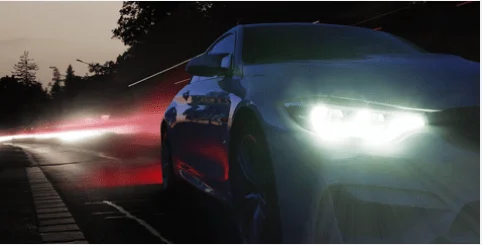
Car Lights – Do You Know The Rules?
As if there weren’t already enough rules on the road, how much do you know about car lights? It is important to have the necessary knowledge for effective overall car maintenance and road safety. With so many different laws regulating the type of car lights we can use on the road, it is imperative that drivers understand the general rules and regulations.
The laws in many countries not only specify the colour and brightness of car lights but also indicate when you should use your lights. We will cover some of the general rules and regulations for headlights in different countries along with additional guidance on how to properly use them. If you have teenagers about to embark on the road to freedom, do they know how important car maintenance is?
One of the first things to do is educate them on how dangerous it is to drive without checking that their car lights are working. Then it’s all about encouraging them to follow the rules, not just in terms of legalities but also to remain safe on the road.
Headlight Specifications
The majority of countries around the world require white or yellow headlights. While there are different laws in different countries, many agree that halogen bulbs with a colour temperature exceeding 4200K are not legal to use. This is primarily as a result of the blue tint that bulbs produce when they reach high colour temperatures. In many cases, these lights appear similar to those of emergency services which could easily cause confusion or dangerous distractions on the road.
In addition to the colour, car lights must be bright enough to clearly see the road and also for other drivers to see you. The brightness of bulbs used to be based on wattage but modern technology means that brighter car lights use less energy. Many local authorities have now implemented laws that headlights must be capable of illuminating the road a few hundred metres ahead of the vehicle. This means that regardless of wattage, drivers can still see obstacles far in advance.
Daytime Driving Rules
Contrary to popular belief, car lights are not only intended for driving at night as there are also instances when you should use them during the day. Brake lights should instantly come on when you hit the brake pedal but avoid excessive braking when in stuck in traffic as it may cause unnecessary glare for those behind you.
More importantly, you must always use headlights and fog lights during the day when visibility is poor such as heavy rain, mist or fog. Just remember to switch them off again once visibility improves so you don’t distract other road users. Use dipped headlights in dull daytime weather to make it easier for other drivers to see you.
When it comes to sidelights and rear registration plate lights, make sure they are always on between sunset and sunrise. In 2011, the EU effectively ruled that all new cars must have daytime running lights that automatically switch on when starting the engine and turn off when headlights or sidelights are activated.
Rules When Driving At Night
Night time, or the hours of darkness, is the period between half an hour after sunset and half an hour before sunrise. This is according to Laws RVLR regs 3, 24, & 25, (In Scotland – RTRA 1984 sect 82 (as amended by NRSWA, paragraph 59 of Schedule 8)).
The key to driving at night is having effective lighting for two main reasons; to clearly see where you are going and to ensure that other drivers can see you without blinding them in the process. It may seem obvious but you are required to have two fully functioning headlights located on the front of your car.
Always switch on your headlights at night while keeping them dipped when driving through built-up areas, behind other cars or when approaching other road users. This includes cars, motorbikes, pedestrians, cyclists and even horse riders.
Many of you would have experienced bright approaching headlights so you know how important it is to keep them dipped, especially when overtaking. If this happens to you, simply slow down or stop if necessary, and only continue when you can clearly see the road ahead.
Regardless of where you drive or which laws are in place, it is simply common sense to have working headlights that enable you to see the road ahead. While you can legally only use sidelights at night when driving under 30mph in a well-lit area, most drivers use dipped headlights for improved visibility.
Brake Lights
In many countries including the UK, US, Canada and Australia, the law requires that brake lights and tail lights should be red. It goes without saying that your brakes are extremely important and so are your brake lights. If your brake lights don’t work and your tail lights are dull or dim, it is extremely dangerous, as cars behind you can’t tell when you’re slowing down, especially when braking suddenly.
When stuck in heavy traffic, drivers should apply the parking brake when traffic has stopped instead of pressing the brake pedal excessively. Brake lights can be distracting and doing this will help minimise the glare for road users behind you (Law RVLR reg 27).
Besides the obvious road safety issues, there are also fines in place if something is not working as it should. In some cases, the police may just issue a verbal warning but the following could also happen:
- Receive a fixed penalty notice (£60 fine and three points on your licence)
- Issued a Vehicle Defect Rectification Notice (14 days to fix the fault and provide proof of the repair)
- Your car is taken off the road immediately
Check your brake and rear lights at least once a week, with someone standing behind your car while you do so. It is advisable to replace any faulty bulbs right away. You can also clean the lights to further improve clarity.
In addition to brake lights, you should also check your indicator lights and hazards making sure everything works perfectly. If they are flickering too fast or not working at all, check the fuse first and replace immediately if necessary.
Fog Lights
Driving in dense fog or mist is dangerous with visibility often reduced to only a few feet. Most new cars have at least one extra rear light to make them more visible in fog and although it’s not a legal requirement, it certainly is much safer.
Just keep in mind that you should never use your fog lights when visibility is clear, especially at night as you could easily blind and confuse other drivers. This is not only dangerous but it’s actually illegal and you could receive a non-endorsable Fixed Penalty Notice of £50.
At Elite Garages, we love informing and educating all of our customers on effective car maintenance, new rules and regulations to ensure that you and your family remain safe. If you have a multi-vehicle household, our friendly family-run business offers incredible value for all your motoring needs.
We service all makes and models, old or new, according to the manufacturer’s service schedule while offering competitive prices, excellent customer service with better value than dealerships. If you are concerned in any way about the condition of your car, book a free safety check Elite Garages today. Our expert technicians are here to help you and your family with professional and friendly advice.
About Us
Opening Times
Saturday : 8:30–4:00
Sunday : closed
More Information
Contact UsCustomer Information Pack
Check MOT Due Date
Free MOT reminder
Careers



Leave a Comments
You must be logged in to post a comment.